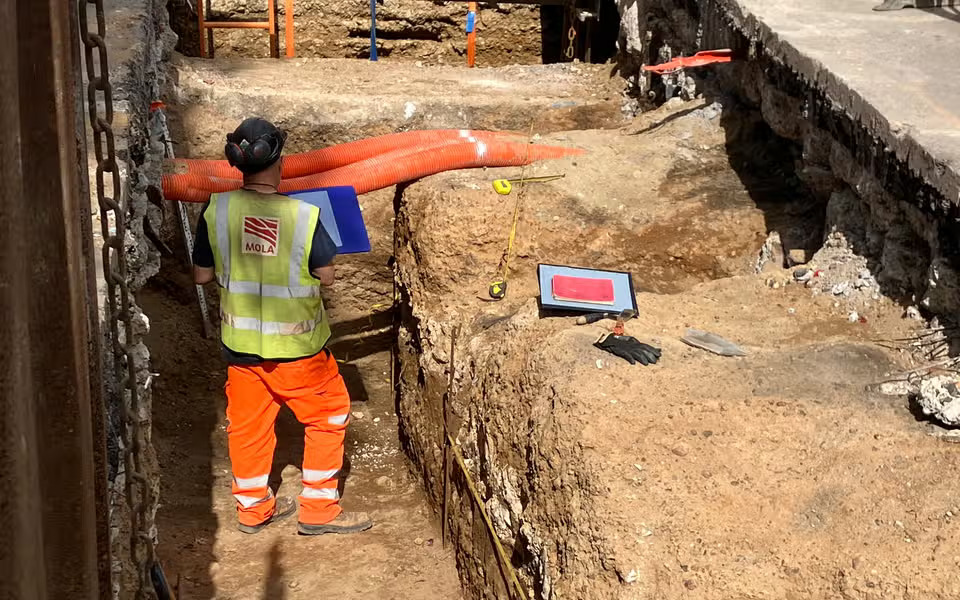
Part of one of Britain’s most important Roman roads unearthed under London’s Old Kent Road
A section of Roman road, part of one of the most important roads built in Roman times, has been unearthed beneath Old Kent Road in south-east London.
The 2,000-year-old road, known as Watling Street, was part of a route from the ancient Roman port at Dover through London to the West Midlands.
Regarded as one of the most crucial Roman roads in Britain, this unexpected discovery was made during excavation work carried out by Southwark Council and the utility company Veolia, aimed at installing a low-carbon heating network.
Constructed shortly after the Roman invasion of Britain in 43 AD, it has proven quite challenging for archaeologists to identify the exact path it took, despite the fact that Roman roads are typically straight.
📣 Our WhatsApp channel is now LIVE! Stay up-to-date with the latest news and updates, just click here to follow us on WhatsApp and never miss a thing!!
“In the planning stages of this project, we anticipated addressing this issue, but the remarkable preservation of the road is surprising. We hope this initiative will help resolve other archaeological inquiries within the borough,” stated Dr. Chris Constable, the in-house archaeology officer for Southwark Council, in an interview with BBC.
The road was uncovered by a group of archaeologists from the Museum of London Archaeology (MOLA), with Dr. Constable offering essential guidance and support.
According to Southwark Council, this discovery provides the first tangible evidence that portions of the road still exist directly beneath its contemporary equivalent, the Old Kent Road.
The well-preserved road segment, which is located south of the intersection of Old Kent Road and Ilderton Road, is roughly 19 feet (5.8 meters) wide by nearly 5 feet (1.4 meters) high.
Southwark Council said distinct layers could be seen and showed a solid foundation of compacted gravel sealed by two layers of chalk, before it was topped with another layer of compacted sand and gravel.
The original surface of the road would likely have been made from the same material and sat at a similar level to the modern road, but this has been lost, says Southwark Council. The base of the modern road was built directly on the Roman fabric.

Gillian King, director of archaeology at RPS Consulting Ltd, described the discovery as “a key finding for archaeological research for London”.Archaeological-themed apparel
“The discovery of an intact section of Roman Wating Street directly under the current Old Kent Road has redrawn the Roman road map for Southwark and informs on Roman construction techniques generally,” she said.
Dave Taylor, MOLA’s project manager, said: “It’s amazing this section of road has survived for almost 2,000 years.”
He added: “There has been so much activity here over the past few hundred years, from sewers to power cables, tramlines and of course the building of the modern road, so we’re really excited to find such a substantial chunk of Roman material remaining.”
The discovery will be marked by a sign on the nearby Old Kent Road bridge. Find out more about the renewal of Old Kent Road at oldkentroad.org.uk
Cover Image Credit: Layers of chalk, sand, and gravel can be visible on the road. Southwark Council
You may also like
- A 1700-year-old statue of Pan unearthed during the excavations at Polyeuktos in İstanbul
- The granary was found in the ancient city of Sebaste, founded by the first Roman emperor Augustus
- Donalar Kale Kapı Rock Tomb or Donalar Rock Tomb
- Theater emerges as works continue in ancient city of Perinthos
- Urartian King Argishti’s bronze shield revealed the name of an unknown country
- The religious center of Lycia, the ancient city of Letoon
- Who were the Luwians?
- A new study brings a fresh perspective on the Anatolian origin of the Indo-European languages
- Perhaps the oldest thermal treatment center in the world, which has been in continuous use for 2000 years -Basilica Therma Roman Bath or King’s Daughter-
- The largest synagogue of the ancient world, located in the ancient city of Sardis, is being restored











Leave a Reply